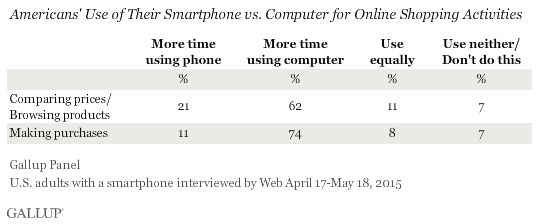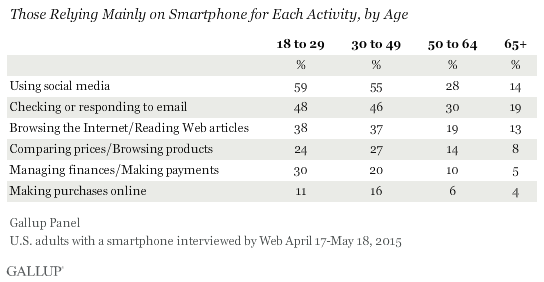Most Smartphone Users Still Rely on Computer for Web Purchases
Tuesday, July 21st, 2015
U.S. smartphone users rely on their device for a variety of everyday tasks, including connecting on social media and using email. Nevertheless, when it comes to the marketplace, 74% of U.S. adults with a smartphone say they mainly turn to their computer for making purchases online. Nearly as many also lean more on their computer (62%) than their smartphone (21%) for browsing products or comparing prices online.

Far fewer smartphone users rely on their phone than on their computer for window shopping and making purchases online, and relatively few say they spend an equal amount of time doing so on both devices: 11% for browsing products and comparing prices, and 8% for making purchases.

These results are from a Gallup Panel survey conducted via Web in April and May with 15,776 U.S. adults who say they have a smartphone.
Smartphones Strongest for Personal Communication
Of the six online activities Gallup measured, using social media such as Facebook, Twitter or LinkedIn is the only activity Americans say they conduct more by smartphone (44%) than computer (24%). Another 13% say they use the two devices equally for this purpose, while 20% say they do not use social media.
Smartphone users have also embraced accessing email by phone. Americans are evenly split in their preferred mode for checking and responding to email: 39% mainly use their smartphone to do so, while 40% prefer using their computer. An additional 20% say they spend the same amount of time on each.
At the same time, the scale tilts toward using a computer for reading online articles (51%), managing finances (59%), comparing prices or browsing products (62%) and making purchases (74%) -- four activities that can require a significant amount of time and Internet navigation. (See table at the end of this article for full results for each activity.)
Big Generational Divides in Most Smartphone Activities
While it is well-established that far fewer seniors than younger Americans use a smartphone, even seniors who have one are significantly less likely than younger smartphone users to rely on it for several non-telephone-related purposes.
The generational divide falls at the 50-year mark, as similar percentages of 18- to 29-year-olds and those aged 30 to 49 report they mainly use their smartphone -- rather than their computer -- for most of the activities Gallup measured. However, those percentages drop after age 50. Regardless of age, though, less than half of any age group relies mainly on their smartphone for using email or Internet surfing, and the rate drops to less than a third for browsing products, managing finances and making purchases online.

There is a distinction between the two younger age groups for managing finances and making payments online, for which 30% of those aged 18 to 29 versus 20% of those aged 30 to 49 rely mainly on their smartphone. On the other hand, 30- to 49-year-olds (16%) are slightly more likely than younger adults (11%) to use their smartphone for making purchases online. This activity falls into the single digits for those aged 50 and older.
For all activities but email, the percentages relying mainly on their smartphone drop by about half among those aged 50 to 64 versus younger adults, and then sink further among those aged 65 and older. One exception to this is using email, for which the decline by age is not quite as steep.
Bottom Line
With smartphones becoming ubiquitous in the U.S. and most adults owning or having access to a computer, consumers have powerful options for communicating, managing their money and shopping, all of which are made easier by digital technology. But these tasks have varying levels of difficulty, with some being easier to navigate on the larger screens of desktop and laptop computers than on even the biggest smartphones.
Perhaps the online activity most important to the economy is e-commerce, as the convenience of shopping and making purchases "anytime, anywhere" should, in theory, increase consumer spending. As reported this week in The New York Times, retailers hoping to maximize these impulse dollars are keen on simplifying the process on smartphones, on which people now spend so much of their time. But smartphone-based commerce has a long way to go, even with the youngest generation, as most smartphone users still prefer to browse and make purchases on a computer. While Amazon offers customers one-click purchasing, thus avoiding the tedium and potential error involved with entering credit card and address information, even this is not a perfect solution for first-time buyers, and is often not available on most other retailer sites. Until that changes, the computer may remain the device of choice for e-commerce, meaning retailers ought to continue optimizing the large-screen online retail experience for consumers.


